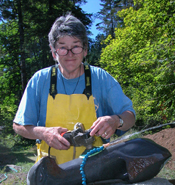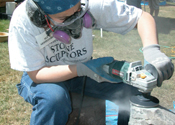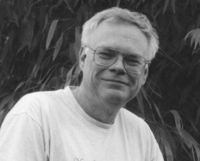- Details
-
Created: Saturday, 02 November 2002 05:25
This year was Elaine MacKay’s first as the new coordinator for the Silver Falls Symposium, and she was worried. Would she do a good job? Would people have a good time? Would everything work out? The calendar slot was also new, the week following Labor Day. Would it rain, and if it did, how much, and for how many days? Would there be enough attendance for the symposium to break even? Was it possible to end up with symposium money to help next year? How would the auction turn out? If enough people even signed up for the symposium, would they bring donations to the auction? Then would these people—if they did show up—buy anything? What about the t-shirts? Did she get the right sizes? Would they sell? She worried. She fussed. She called everybody and their aunt to see if they were coming. She sweated and stewed. Being well-organized was proving a curse. Every time she thought of something, it became something more to worry about.
But there was nothing to worry about. Good people have good Karma. When Elaine and the symposium crew arrived at Silver Falls so did the first of the crazy, wonderful group that formed over the next few days. (At different times, 33 people stayed over and several more people came for day sessions.) We filled what we expected to fill, then we found some cabins up the road that were, thankfully, empty. Each day brought more people—and more—and more. (The registrar, yours truly, got stressed out and took a hike to rant to the trees.) And they continued to arrive. “If you build it, they will...” well, you get the idea.
Elaine and I were roommates, and that first night we were joined by Suz Gentiluomo, who camped in a sleeping bag on the floor between our bunks. Poor Suz. Elaine snores. Being a lady, I certainly don’t snore. However, I do on occasion breathe somewhat heavily in my sleep. I was wondering if Suz got even a minute of good sleep. She had expected to drop by Silver Falls to say “Hi,” and then go on to Salem to spend the night with her sister. She had assumed that she could ask for directions. And it was true—she could ask. However, the only people there, so far, didn’t know the area, except me, and I was honest with her about being directionally impaired. So, instead of getting good directions she could follow after dark, she ended up camped on the floor between INhale and EXhale. Thank the gods; she was able to move on to her room the next day, before her health was impaired by her lack of sleep.
Carolyn Anderson was our Master Masseuse. We didn’t see much of her except at mealtimes and at the auction, but could tell that she was there by the people who disappeared for hours, then showed up again, wandering around with that dreamy look and those rubbery knees that bend every which way. (Anybody else would think they’d been abducted by aliens, but we knew better.)
Randy Zieber was our stone vendor. He brought just the right stones to turn our pockets inside out. His trailer was the local hangout while he was there. It was addictive. I would glance over and say to myself, “Oh, look at all those people chatting about stone. Isn’t that nice? But I have enough stone, so I’m not going to buy anymore.” Then someone would turn a stone over and it would catch my eye and I’d say, “Oh! What’s that?” And I’d wander over to join the crowd of people chatting or standing by some stone, mumbling, “Well, I really shouldn’t.” or “I promised I wouldn’t bring any more home.” or “Where am I going to put it? My driveway is full right now.” or “Damn. I have three other pieces (of limestone/ marble/ granite/ alabaster/basalt) that I haven’t carved yet.” I bought a lovely piece of chlorite and the most beautiful, perfect piece of butter yellow marble. Randy holds checks. Did you know that?
Alexandra Morosco was our tool vendor and one of our instructors. She, as always, shared her knowledge of both tools and stone with expertise and enthusiasm. And, as always, she got the portion of our money that Randy somehow missed. (It’s an unspoken agreement between them. If she sees us first, he gets the remainder of our money.) She thought she was going to get out early on the last day, but we didn’t let her go that easily. We had dredged up a little more coin from under the mattress, and it, too, was quickly traded for the real sign of wealth: good tools.
Paul Buckner—if he’s not the sweetest man alive, he’s darned close—was our Professor of Anatomy, and did a wonderful job. He has a very understandable, practical method of explaining the body structure, and a judgment-free manner when giving advice to students. I think he could take a person whose talent is completely flat-lined and breathe some life into it.
Tom Small was our new instructor this year. It was quite a picture, this soft-spoken, gentle soul telling us how to create in, take control of, and shape basalt with power tools. He also shared his free-flowing method of engaging the creative part of the mind. He was able to break it down so we could see it from beginning to end, without taking any of the magic out of it. It was very interesting.
Stu Jacobson was our Fountain Master again this year. He gave us detailed, practical information on building both small and large fountains. When he did a class on water and the different sounds and affects that will result from the shapes, sizes, and distances of objects interacting with water, I thought about last year when he tried to do the same thing. In that class, when he talked about the sounds water will make, we were dumping great pools of water that had gathered in the tent roof while more poured outside, and he just had to say, “Well, take my word for it.” This year we could actually hear the differences.
We had wonderful weather every day. It didn’t rain once! The sun was shining and the air was just cool enough to carve comfortably, but not cool enough to make people cold all day. Suz said it was sunny the whole time because we were all armed with raingear. That must have been the case, because after we left, it rained.
Carole Duree-Jones was our Wine Steward and Brewmeister. She caught a lot of flack about being a teetotaling wine steward who lacked a proper wine cellar. (Carole, Elaine promises that next year she will assign you jobs that are more appropriate to your talents.) One talent of Carole’s that was used well was her typesetting skills. She updated and made the mail out packets this year, and I heard a lot of compliments about how well done they were. Carole, along with Jim
Heltsley, formed part of our auction team. Jim did us the additional favor of making his map of the meadow and where each person was set up. His maps are very popular.
During the auction, Elaine had Lane Tompkins and Don Lown to help keep us in hysterics most of the time. Elaine was our Master Auctioneer. If you’ve never seen Elaine in action as auctioneer, you’ve missed some real auction, uh, action. If you missed the “Lane and Don Help Elaine Sell” show, all I can say is you missed a life-enriching experience. Lane and Don both located previously untapped resources within themselves as models. Lane modeled various items of clothing with grace, charm, and panache. Some of them actually sold. (Lane, I’m sure the others will sell another time.) Don used a handcart as I’ve never seen one used before. He escorted each rock down the runway with the showmanship usually seen only at a beauty pageant. To Don’s credit, all rocks sold. (Of course, he was playing to a crowd that was a sure thing.)
During the auction, Elaine surprised me with a gift that really touched my heart. Peter Andrusko had carved the Chinese character for “virtue” in French limestone while he was at the symposium, and he donated it to the auction. It’s beautiful. (Elaine and Paul didn’t know when they planned to get
 Q: I was told that as a beginning carver I should avoid stone that has a lot of colored bands or layers. Why? Is colored or banded stone more difficult to carve?
Q: I was told that as a beginning carver I should avoid stone that has a lot of colored bands or layers. Why? Is colored or banded stone more difficult to carve?


